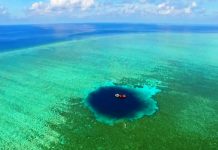Movile Cave is a cave located in Mangalia in Constanța County, Romania, a few kilometers from the Black Sea coastline.
Cristian Lascu discovered Movile Cave in 1986 during a geologic survey above a derelict mining pit in Mangalia. Its groundwater is rich in hydrogen sulfide and carbon dioxide but deficient in oxygen. Locked down about 60 feet below the surface of the earth, it is not naturally connected to the outside world.
Life in the cave has been isolated from the outside world for the past 5.5 million years, and it is entirely based on chemosynthesis rather than photosynthesis. Nevertheless, Movile Cave is cramped in spite of its amazing abundance. The only access to a horizontal labyrinth of winding limestone passages, dotted with odd growths, is a tiny, man-made shaft.
Although it is home to a variety of odd species, its air is heavy with dangerous gasses. To avoid disrupting the fragile ecosystem, the cave is inaccessible to the general public and only a few researchers are allowed inside each year. Movile Cave is a about 200-meter-long system of limestone pathways, some of which are completely or partially submerged in hydrothermal waters. The air and water have a consistent temperature of 21 °C, and the relative humidity is roughly 100%.
The atmosphere outside and the air inside the cave are somewhat different. Only a third to half as much oxygen and roughly 100 times as much carbon dioxide are present. The cave’s air and water include significant levels of hydrogen sulfide (H2S) and ammonia (NH3), and it also contains 1% to 2% methane (CH4). The lake’s water dissolved oxygen for the first millimeter in certain locations and only for the first centimeter at most. The water in the lake becomes totally anoxic as it descends farther.
There are 57 known species in the cave, including woodlice, pseudoscorpion, centipedes, water scorpions, leeches, spiders, and snails. However, 37 species are native. The chemosynthesis of sulfur and methane-oxidizing bacteria, which releases nutrients for other bacteria and fungi, is the foundation of the food chain. This creates microbial mats on the cave walls and the surface of ponds and lakes, which some of the animal’s graze. After that, predatory species prey on the grazers. Nepa anophthalma is the only water scorpion in the world that has been known to adapt to Movile caves.
Remember, myriad animals have inhabited the cave for 5.5 million years, but not all of them came at once. The cave’s sole species of snail, (Heleobia dobrogica), lived here for over 2 million years. This specie is among the newest organisms known to science. To reduce outside influence on the fragile environment, only a small number of researchers are allowed access to the cave each year.
Similar caves where life depends on chemosynthesis have been found in Tashan Cave (Iran), Ein-Nur Cave and Ayalon Cave (Israel), Villa Luz Cave (Mexico), Frasassi Caves (Italy), Melissotrypa Cave (Elassona municipality, Greece), caves in the Sharo-Argun Valley in the Caucasus Mountains, Lower Kane Cave, and Cesspool Cave (Wyoming and Alleghany County, VA, USA).
Read More: Turda Gorge





Reference 1,






